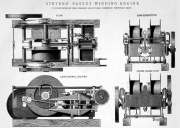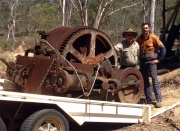Difference between revisions of "Uskside Engineering Co"
| Line 13: | Line 13: | ||
1883 The firm was converted into a limited liability company | 1883 The firm was converted into a limited liability company | ||
1885 '''Uskside Engineering Co''' exhibited an underground self-contained hauling engine<ref>London Gazette 12 August 1885</ref> | 1885 '''Uskside Engineering Co''' exhibited an underground self-contained hauling engine<ref>London Gazette 12 August 1885</ref> based on Stevens' design. | ||
1889 The '''Uskside Engineering and Rivet Co''' Ltd. agreed to supply the Philadelphia and Reading Railroad Co., of USA, with their Stevens Improved Patent Fuel Presses, for 5 years. The Philadelphia and Reading Railroad transferred all of its interest in the patents, machines and inventions made under its agreement with Usk Engineering to the Reading Anthracite Pressed Fuel Co. | 1889 The '''Uskside Engineering and Rivet Co''' Ltd. agreed to supply the Philadelphia and Reading Railroad Co., of USA, with their Stevens Improved Patent Fuel Presses, for 5 years. The Philadelphia and Reading Railroad transferred all of its interest in the patents, machines and inventions made under its agreement with Usk Engineering to the Reading Anthracite Pressed Fuel Co. | ||
Revision as of 17:00, 19 July 2020

Uskside Iron Works Co, of Newport, Monmouth.
Presumably had been carried on as Uskside Iron Co until the 1860s.
1866 Arthur James Stevens became a partner
1883 The firm was converted into a limited liability company
1885 Uskside Engineering Co exhibited an underground self-contained hauling engine[1] based on Stevens' design.
1889 The Uskside Engineering and Rivet Co Ltd. agreed to supply the Philadelphia and Reading Railroad Co., of USA, with their Stevens Improved Patent Fuel Presses, for 5 years. The Philadelphia and Reading Railroad transferred all of its interest in the patents, machines and inventions made under its agreement with Usk Engineering to the Reading Anthracite Pressed Fuel Co.
1898 Expansion of the forge department
Maker of stationary engines. [2]
Sometimes after 1906 the title was changed to Uskside Engineering Co
1907 Sale of the Rivet Department
WWI By May 1915, it was already producing proof shot for naval guns and 18 pound shells. A new erecting shop for 6-inch shells was built. This shop was fitted with the latest equipment to reduce handling to a minimum, including bench conveyors which kept the shells at the same level as the lathes from start to finish and therefore made it possible to employ a greater number of women in the shop.
Acquired as a going concern by the Ministry of Munitions for the duration of the war as the Uskside National Works; the works were managed by a Board of Management composed of the former directors of the company plus a nominee from the Ministry of Munitions.
In addition to proof shot, 18 pound and 6-inch shells, the works also manufactured pedestals for naval guns, gun carriage forgings, breach pieces for trench mortars and ships’ forgings such as shaftings and rudder mechanisms, making it something of a general purpose factory.
During the war it also continued to undertake urgent repair work for collieries.
Final production figures for the Uskside National Works include the manufacture of 24,500 18 pund shells, 16,100 4.5-inch shells and 119,700 6-inch shells.
1920 The works reverted to the control of Uskside Engineering on 31st March.
1920 Issued catalogue on electric haulage gear and details of forging in iron and steel. [3]
1943 Acquired by John Lysaght, part of GKN.
1970 Formation of GKN Birwelco (Uskside), a new trading company amalgamating the electric furnaces division of Birwelco and Usk Engineering[4]
See Also
Sources of Information
- ↑ London Gazette 12 August 1885
- ↑ Stationary Steam Engines of Great Britain by George Watkins. Vol 10
- ↑ The Engineer of 27th Feb 1920 p234
- ↑ The Times, Mar 06, 1970
- Papers in Gwent Record Office [1]
- GGAT 130: The Sinews of War: South East Wales Industry and The First World War, 2015, by Johnny Crawford





